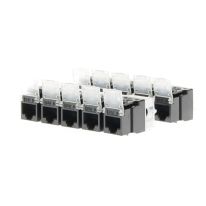Shop Keystone and Australian Style Cable Jacks By 4Cabling
Are you looking to complete your networking project with high-quality jacks that will give it the professional finish it deserves?
At 4Cabling, we understand that different projects require different jack variations, which is why we stock a wide range of jacks with different features. For example, we offer RJ45 jacks with 90 Degree Shutters, extra shielded jacks, and jacks with universal termination capabilities. We also stock Cat5E jacks, Cat6 jacks and Cat6A jacks.
Our jacks come in packs ranging from 1 to 100 individual pieces, making it easy to buy the exact number you need. We also stock a range of related data products, including keystone faceplates and shielded keystone jacks to complete your networking setup.
You can browse our extensive range of keystone and cable jacks products online! If you have any questions about which products would work best for your setup, you can visit our contact us page and a member of our customer service team will be in touch shortly.
FAQs
What is keystone jack used for?
A keystone jack is a female connector used in data communications. It is a small, rectangular module, designed to fit into a standard-sized rectangular port, known as a keystone wall plate, which provides a neat and organized appearance. It is the standard plug-in for mounting low voltage electrical and is primarily used in local area networks (LANs).
They are particularly useful for structured cabling systems that require a high degree of flexibility and scalability. Keystone jacks can be easily swapped out or replaced without affecting the rest of the cabling system.
For example, a CAT6 keystone jack can be used to terminate CAT6 cabling, which is designed to support up to 10Gbps over a distance of 55 meters. Similarly, a CAT6A keystone jack can be used to terminate CAT6A cabling, which is designed to support up to 10Gbps over a distance of 100 meters.
Is there a difference between Cat6 and Cat6a keystone jacks?
Yes, the main difference is that CAT6A is able to transmit 10 Gbps over longer distances than Cat6 (approximately 100 meters as opposed to 33-55 meters). What’s more, Cat6a is also more efficient at protecting a network against alien crosstalk, which is the interference of a wire inducing noise into other neighboring cables.
What is a RJ45 network jack?
High-capacity appliances should not be plugged into a surge protector as they require a lot of power to work. If a device is plugged into a surge protector with a load rating that is lower than the amount of power that device needs to operate, this will result in a power overload. Power overloads are extremely dangerous as they could potentially start an electrical fire.
High-capacity appliances that should not be plugged into a surge protector include:
- Standard kitchen appliances including refrigerators, microwave ovens, toasters, rice cookers, blenders and coffee makers
- Washing machines and dryers
- Electronic hair styling tools and hair dryers
- Portable air conditioners and heaters
Are RJ45 and Ethernet the same?
RJ45 and Ethernet are not the same, but they are closely related. RJ45 refers to the connector used to terminate Ethernet cables, while Ethernet refers to the family of networking protocols and technologies. Ethernet cables have an RJ45 connector on both ends and are often used to connect computers to Ethernet networks. High-speed modem and other computer network applications are supported by RJ45 connectors.
What is the difference between RJ11 and RJ45?
RJ11 and RJ45 are both types of connectors used in telecommunications, but they are not interchangeable.
RJ11 connectors are commonly used to connect telephones to a wall socket. They have four pins arranged in a single row and can support up to two telephone lines. On the other hand, RJ45 connectors are used to terminate Ethernet cables and have eight pins arranged in a rectangular shape.
Since RJ11 connectors have fewer wires, they are smaller in size compared to RJ45 connectors.
It's important to note that RJ11 cables are not compatible with RJ45 jacks. Attempting to plug an RJ11 cable into an RJ45 jack can cause damage to the port or even affect the power delivered. So, it's crucial to make sure you're using the right connector for the right application.
You can browse our range of RJ45 keystones and cable jacks on our website. If you have any questions about the products, and which option would be a better solution for your setup, don't hesitate to contact us.


















